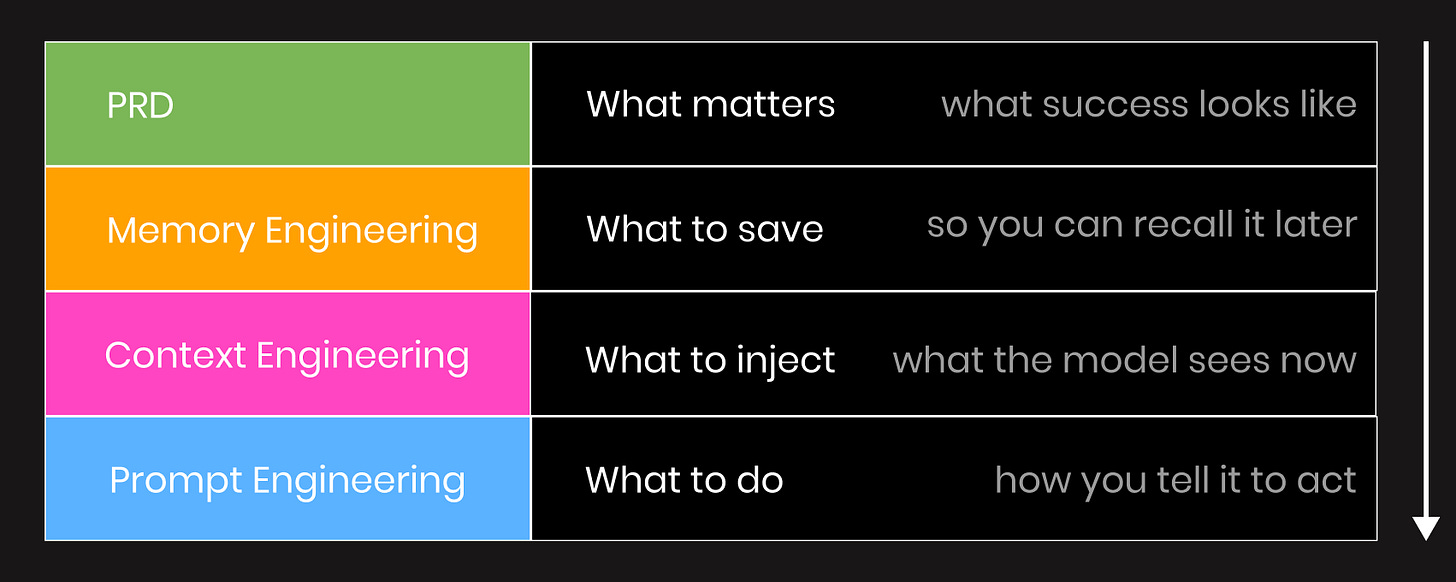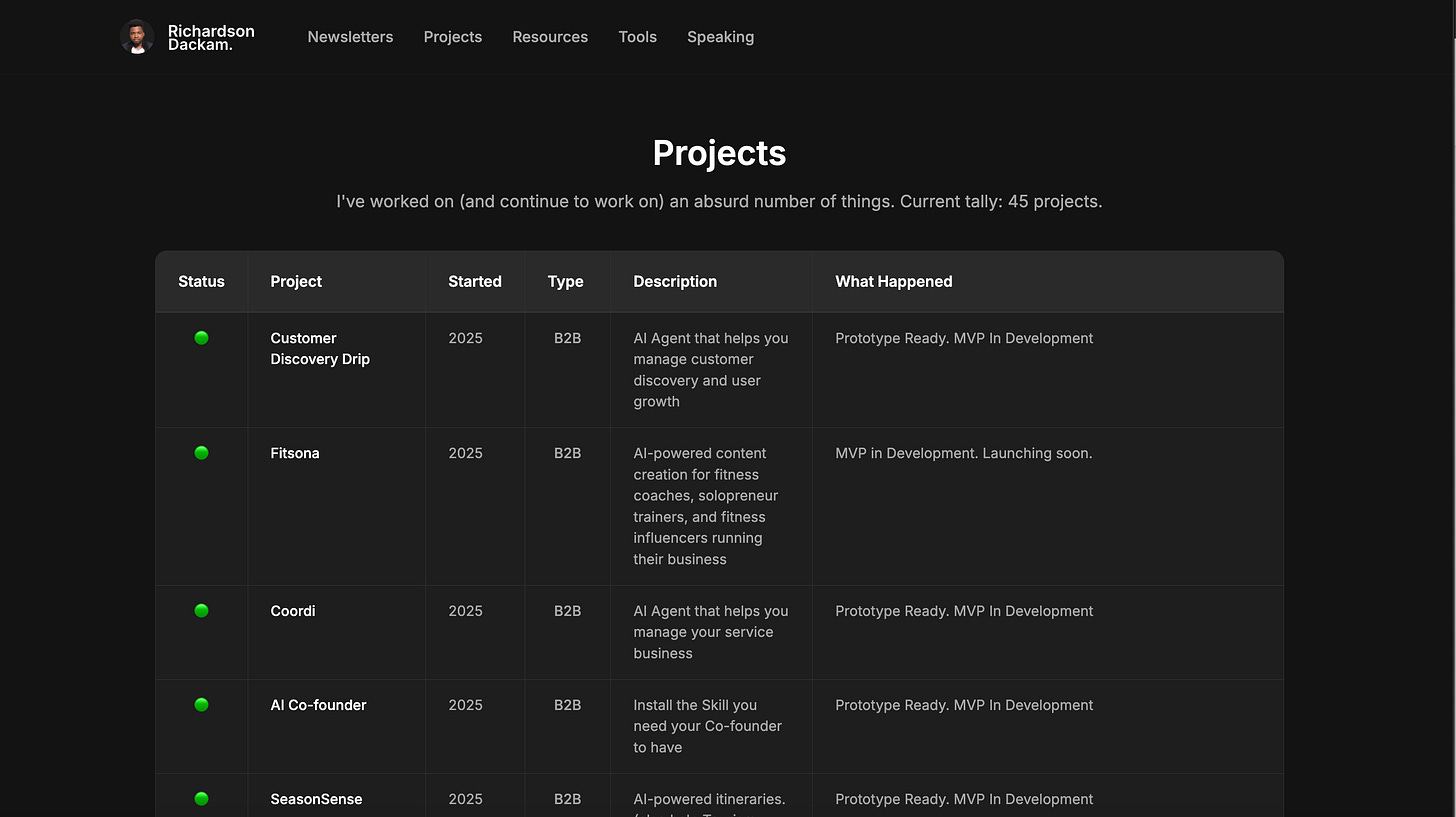The Most Important AI Skill Nobody’s Teaching
You’ve learned prompt engineering and context engineering. But without memory engineering, everything breaks in round two.
You’ve written a good prompt. You’ve loaded the right files. You’ve given your agent clear instructions.
And still…
It forgets what you just fixed.
It skips part of the feature.
It breaks something it already repaired.
It rewrites the same file three times.
It gets confused about how your system even works.
No, it’s not dumb.
No, your prompt isn’t bad.
You’re just missing the piece that holds it all together.
It’s not your PRD.
It’s Memory Engineering, and most people aren’t even thinking about it.
Wait… Don’t I Already Have Memory?
You might think your AI “remembers” stuff because you’ve got:
✅ A solid PRD (check)
✅ Files loaded in the context window (check)
✅ Cursor Memory
That gets you one round of good work.
But what happens in round two?
When the agent jumps to a different file, or revisits a bug you already solved, or forgets the system constraint you told it ten minutes ago?
You might already have a clear PRD.
Your prompt might be well written.
You might even be injecting the right files with context engineering.
But here’s the gap:
PRD → defines what to build
Prompt Engineering → tells the AI what to do
Context Engineering → tells the AI what to see right now
Memory Engineering → decides what should be saved for future tasks
Rules → decide when and how that saved memory gets injected
Memory Engineering is about curating the durable knowledge you’ll need later.
Rules are the triggers that pull the right slice into the context window at the right moment.
Without memory, you get isolated flashes of good output.
With it, your entire workflow becomes repeatable, traceable and far more accurate.
The Real Job of Memory
Memory Engineering isn’t about giving AI some mystical ability to remember everything.
It’s about giving you control over what the model can reliably access later across tasks, across sessions, across teammates.
This is how you:
Stop AI from reintroducing the same bug
Make sure the model respects your architecture decisions
Keep instructions clean and repeatable without bloating every prompt
Track progress in a way that future-you (or a future AI) can understand
Preserve key assumptions and decisions, so you don’t fix the same thing twice
In short: memory is how you build continuity into your AI workflows.
Without it, you're stuck re-explaining everything again and again.
The 4 Pillars of AI Development
Most people know about prompts. Some know about PRDs and context.
But almost no one talks about how it all fits together — or what’s missing.
Here’s the full stack:
You can write a great PRD.
You can craft a sharp prompt.
You can inject the right files with context.
But none of it sticks unless you decide what should persist across tasks and when to bring it back in.
That’s where Memory Engineering comes in.
PRDs define success
Prompts drive execution
Context tells the model what to see
Memory handles continuity: what needs to be remembered across time
Cursor helps automate context beautifully ad tools like Cursor Rules or Cursor Memory can help with persistent memory to an extent
But deciding what to store, how to organize it, and when to surface it?
That’s your job.
Memory isn’t about giving the model a perfect brain.
It’s about building a repeatable system so your agent isn’t starting over every time.
So What Does Memory Actually Look Like?
It looks like a simple folder.
Seriously.
But this folder isn’t meant as a documentation for humans.
It’s meant as a resource to feed the model just enough memory at the right time.
You’re not expected to dump all of this into every prompt.
The way you use it, is by loading what matters per task.. and with guardrails.
How This Fixes the Most Common AI Headaches
If you’ve used Cursor, you’ve seen this:
You inject a few files. You give an instruction. It executes... well sort of. Then you realize:
It undid a fix you made yesterday.
It ignored the file structure you already showed it.
It missed your naming conventions.
You’re completely confused about what just happened, and now you’re stuck re-explaining it.
Now imagine this instead:
You inject progress.md, and the AI understands what’s already been shipped.
You inject fix-guides/auth-bug-02.md, and it avoids reintroducing a bug you fixed last week.
You write a short post-mortem after each major edit and that becomes memory, instantly.
This is where memory stops being optional.
Without Memory Engineering:
You don't have a clear log of progress and decisions aren’t consistent.
The way I think about it, is that Cursor’s Rules and Memories give you primitives for persistence but it's up to you to curate and control what gets saved and when Cursor should use it
Rules: The Glue Between Memory and Context
The hardest part isn’t writing memory…. it’s using it well.
That’s where rules come in.
Rules tell you when to pull memory into the context window.
Because you don’t want to overload every prompt with everything.
Actually, you want surgical precision ( I mean it)
For example This is how I do
When I’m working in
auth/, I inject architecture/auth.md and the related fix-guide if I’m worried to face a recurring issue.Before working on a new feature, I feed it progress.md and ask to update it
Before asking the AI to refactor anything, I feed it architecture.md and any feature related diagram.
Now the power of rules, is that you can have pre-written selection of what memory should be applied.
S I use rules to tell AI when to use a memory.
If you’re detecting a bug check memory-docs/bug-fixes
Why this matters?
If You Made It This Far...
You now have a weapon 99% of AI builders don’t even think about.
That’s because most builders are stuck in loop mode: prompt → fix → forget → repeat.
You’re now operating at a higher level: design → remember → build → evolve.
You’re not just generating code anymore.
You’re building a system that learns because you gave it a brain and a memory to work with.
Most people never even think to do this. Now you won’t even imagine building without it.
What I’ve Been Up To
I’ve been thinking about Memory Engineering a lot. An all week I’ve been thinking how to best teach this concept. I wanted to make sure the post was complete with this video breakdown ( so this newsletter is coming a bit late.. but there’s another one coming this Saturday)
For a deeper dive into how I generate PRDs you can watch this video about How I generate PRDs to build MVPs in a weekend (or LESS):
I’ve built so many apps and experiments that no one around me can remember what projects I’m working on….
My brother and sister and I were joking about this and decided to make a “map”.
So I launched a Projects page on richdackam.com to track all the projects that I’m working on
Hitting that button has more power than you can image.
if this post made your brain light up, share it.
Drop it in your team’s Slack.
Forward it to your AI engineer friend… ( Especially the one who keeps saying "AI isn’t ready yet )
And Bookmark it for when you start your next build.
See you saturdday, until then…
Learn it to make it!
Cheers!
Richardson











